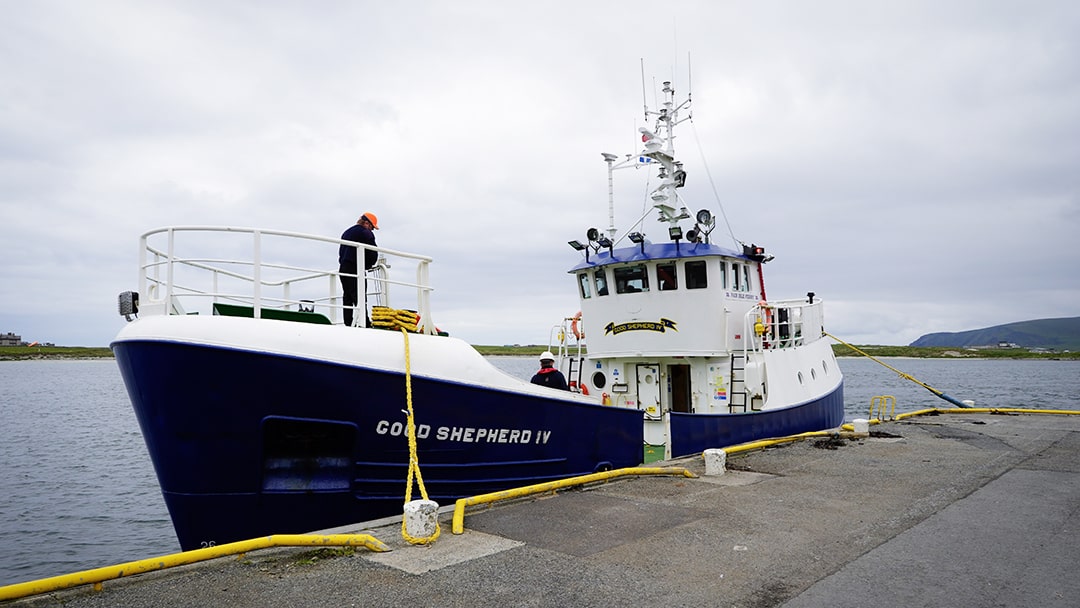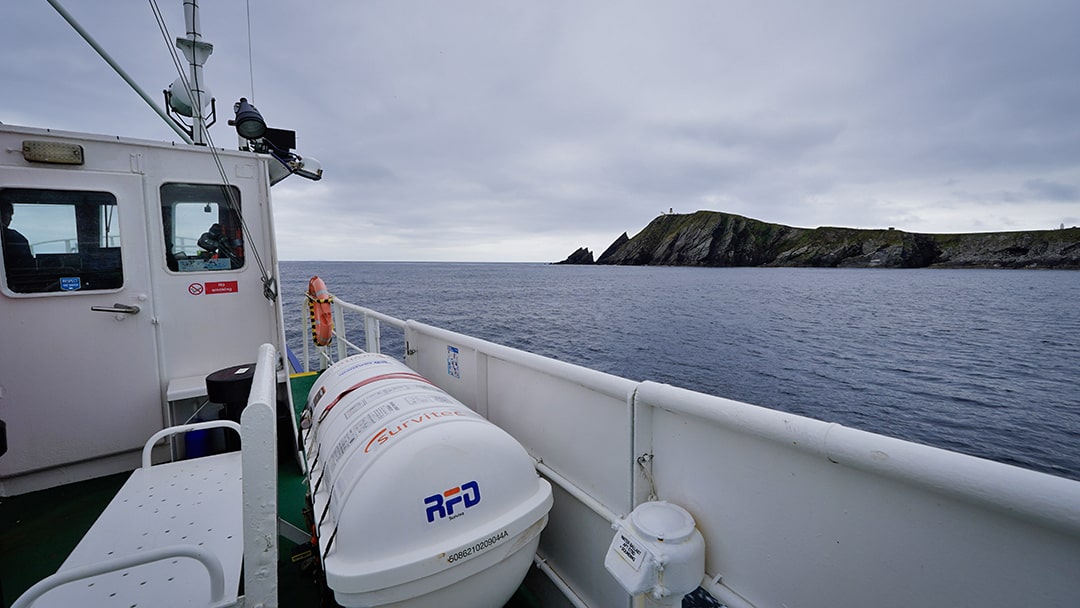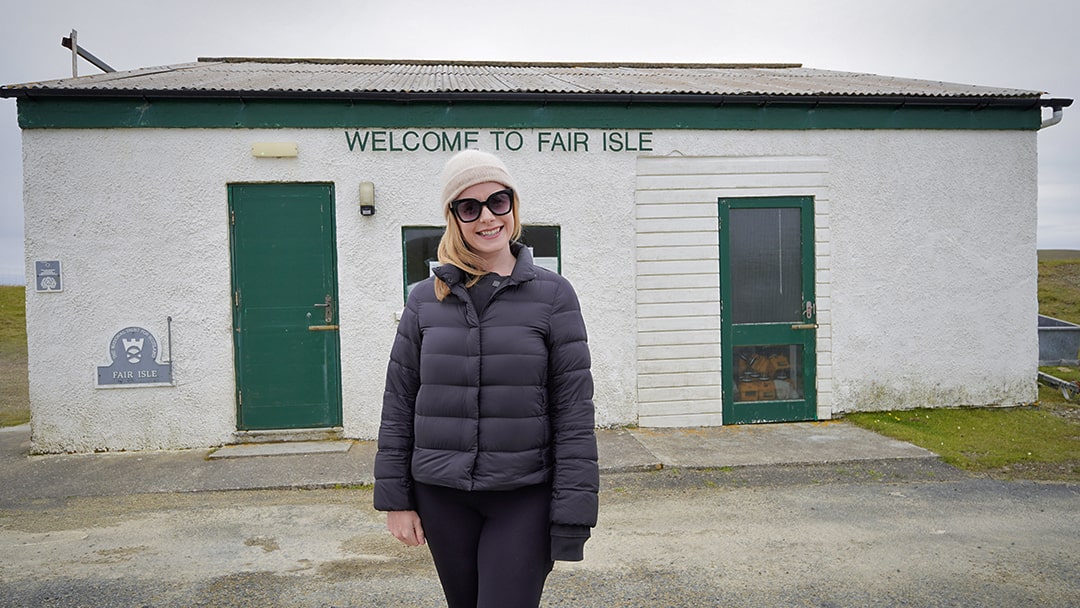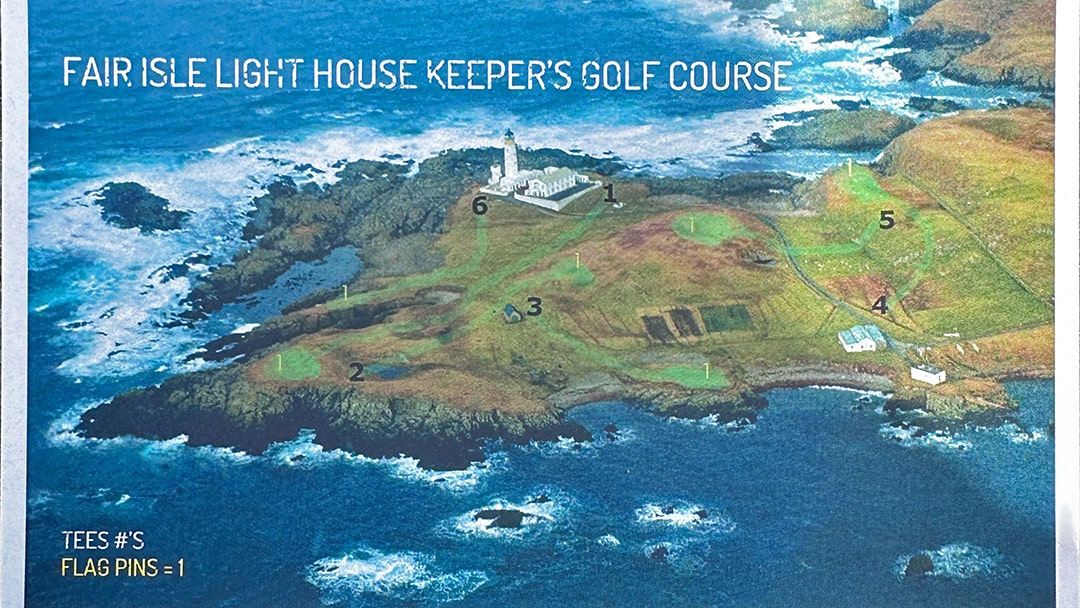A few days on the UK’s most remote inhabited island – Fair Isle
Fair Isle had always intrigued me, known for its iconic knitwear and its reputation as the UK’s most remote inhabited island. But it wasn’t until I caught a glimpse of it from the deck of the NorthLink ferry, as it passed by, that I knew I had to visit. The question was, how?
I wrapped up my final day on Fair Isle with a visit to a spot famous for its puffin colonies. When I arrived, I could hardly believe my eyes, there were thousands of puffins perched on the cliffs and soaring through the air. It was the largest gathering of puffins I’d ever seen in one place!

After some research, I discovered that Fair Isle is accessible from Shetland, either by passenger ferry or a small nine-seater plane. I contacted AirTask, the airline based at Tingwall Airport. To my surprise, booking a flight was as simple as a quick phone call, with no card details needed. It felt wonderfully old-fashioned and trusting.

Arriving at Tingwall Airport on the morning of my flight, I was struck by how small and unassuming it was. This isn’t Shetland’s main airport, that would be Sumburgh, located in the southern part of the Shetland main island. Tingwall serves only Fair Isle and Foula, another of Shetland’s remote outposts, with flights departing most days – weather permitting.
Stepping inside to check in, I quickly learned why I hadn’t been asked to pay in advance. Frequent cancellations due to Shetland’s unpredictable weather must make issuing refunds a logistical headache! The pilot greeted me and explained that a weather front was moving in. While he thought we might be able to make it to Fair Isle, it was unlikely the plane would manage the return trip. As a result, today’s flight was cancelled.
He also mentioned that tomorrow’s forecast wasn’t promising either. However, a passenger ferry was scheduled to depart the next day at 11 a.m. Without hesitation, I made a booking for it. Travelling to remote places like Fair Isle comes with its challenges, and the ever-changing weather keeps you on your toes. For me, though, it’s part of the adventure, the uncertainty of whether you’ll reach your destination only adds to the thrill.

The passenger ferry to Fair Isle departs from Grutness, near Sumburgh Airport in southern Shetland. As I arrived, I watched the friendly ferry crew busily loading food and freight onto the Good Shepherd, the dedicated ferry serving Fair Isle.
Growing up on mainland Scotland, just a short drive from shops and most things I could ever need, I find it fascinating to witness these glimpses into a completely different way of life. Perhaps that’s part of what draws me to remote places and islands – their self-reliance, resilience, and the unique rhythm of life that feels worlds away from my own.

Fair Isle is a popular destination for day trips by flight, you can depart in the morning and return by afternoon. However, I wanted to fully experience what the island had to offer, so I planned a three-night stay.
At the ferry, my luggage was stowed in the freight container, loaded into the hold alongside supplies for the islanders. The crew mentioned I’d be the only passenger today – a surprising detail for July! Moments after boarding the Good Shepherd, we set off, cutting through choppy seas as the imposing silhouette of Sumburgh Head gradually shrank behind us. The crew handed me a few sick bags with a knowing smile. “Just in case,” they said, and I braced myself for the unpredictable journey ahead.
The ferry journey from the Shetland mainland to Fair Isle takes about 2.5 hours, a contrast to the 25-minute flight. Opting to sit outside, I kept my gaze fixed on the horizon, determined to stave off seasickness. During the journey, the crew pointed out fins slicing through the water, perhaps minke whales or dolphins making an appearance! Before I knew it, we were arriving at the harbour on Fair Isle.

There are a handful of places to stay on Fair Isle, and I had booked to stay at the Auld Haa Guesthouse, run by Tommy Hyndman, an American who has called the island home since 2006. In addition to managing the guesthouse, Tommy is also a talented hat-maker and artist. I received a warm welcome from him as he met me off the ferry. On the way to the guesthouse, we made a quick detour to the airfield, where Tommy showed me where I would have arrived had I taken the plane instead.
Tommy lives in the historic Laird’s House, a striking building at the southern end of Fair Isle, where most of the island’s 60 residents reside. He offers two rooms for guesthouse accommodation, and I chose to include both breakfast and dinner during my stay, eager to experience the island’s hospitality.

After a pleasant chat over a cup of tea with Tommy, I set off to explore the island. My first stop was the Fair Isle South Lighthouse, notable for being the last lighthouse in Scotland to be automated, which happened in 1998. It is also the tallest lighthouse in Shetland. As I approached, I had to be cautious of dive-bombing Arctic Terns, fiercely protecting their eggs on the rocks, they clearly weren’t too fond of my presence!

I returned to the Auld Haa Guesthouse just in time for an incredible dinner prepared by Tommy. He is an excellent cook and is also very accommodating of different dietary needs. The meal he served featured fresh seafood from Fair Isle and I couldn’t have been happier that I’d chosen to include meals during my stay.

After dinner, Tommy and I made our way to the Fair Isle North Lighthouse, where he’d mentioned it was an excellent spot for puffin sightings, and if we were lucky, we might catch a stunning sunset. As it turned out, we were indeed lucky. Watching the puffins on the clifftops as the sun dipped below the horizon, casting a golden glow over the distant waters, was nothing short of magical. It was a moment I’ll never forget and the perfect way to end my first day on Fair Isle.
One of the things I was eager to explore more of on Fair Isle was its renowned birdlife. Although the new Fair Isle Bird Observatory was still under construction during my visit, they were still offering ranger-led walks.

After a hearty breakfast at the Auld Haa, I joined one of these free walks and learned about the island’s puffins, their burrows, and the dive-bombing great skuas known locally as “bonxies”. It was fascinating to hear about the important work the bird observatory is doing to monitor bird populations on the island, and it deepened my appreciation for Fair Isle’s unique wildlife.

Next, I visited the island’s museum, which is a fantastic resource, showcasing a range of artefacts from Fair Isle’s rich history. The exhibits cover everything from shipwrecks and lighthouses to the island’s distinctive handmade chairs, with a particularly extensive section dedicated to Fair Isle knitting.
While I was there, I had the pleasure of chatting with Stewart Thompson, a local who had worked as a lighthouse keeper on the island. Connecting with locals and hearing their stories about the past is one of my favourite parts of visiting new places, and Fair Isle was no exception.

After exploring the history of Fair Isle knitting at the museum, I had the pleasure of meeting Marie Bruhat, a skilled knitter who moved to the island in 2017. Originally from France, Marie first visited Fair Isle in 2015 as part of her textiles studies and she fell in love with the island’s knitting heritage. Her passion for the craft led her to move permanently to Fair Isle two years later, where she now runs a studio and offers knitting holidays.
I had arrived on Fair Isle only familiar with the term “Fair Isle knitting,” but it was amazing to learn more about how the distinctive patterns developed and how the tradition is being preserved and celebrated today.

I wrapped up my day with a serene walk through the misty landscapes of Fair Isle, passing by the school, community center, and the shop. The island felt so peaceful, with the only ‘traffic’ being a few sheep leisurely strolling along.

I had heard about Fair Isle’s golf course, a 6-hole course which holds the title of the most remote golf course in the UK. Established in the 19th century by lighthouse keepers from mainland Scotland, the course fell into disuse over time. However, Tommy worked hard to bring it back to life, allowing visitors to borrow clubs and balls and enjoy a unique golfing experience on the island.

Tommy and I made our way to the course, which is quite close to the Fair Isle South Lighthouse and presents a challenging round of golf. As a not-so-skilled golfer, I lost a few balls during my attempts, but the experience was great fun and a wonderful way to take in the island’s stunning scenery.

After my less-than-stellar attempt at golf, I headed back to the harbour. Steven Wilson, a friendly local I’d met on the island had invited me to join him for an afternoon boat trip on his small fishing vessel to explore the bird-filled cliffs. As we made our way alongside the shoreline, we were treated to a stunning view of guillemots nesting in the cliffs.

I wrapped up my final day on Fair Isle with a visit to a spot famous for its puffin colonies. When I arrived, I could hardly believe my eyes, there were thousands of puffins perched on the cliffs and soaring through the air. It was the largest gathering of puffins I’d ever seen in one place. I sat there for hours, mesmerised by the sight of these beautiful birds. It was a perfect, unforgettable way to end my time on Fair Isle.
As I woke in my cosy room at the Auld Haa Guesthouse on my final morning, a feeling unlike any other settled over me, I didn’t want to leave.

As the ferry departed and Fair Isle grew smaller in the distance, I realised that of all the islands I’ve visited in Scotland, none had captured me quite like Fair Isle. Its rugged beauty, the call of the seabirds, the history etched into every corner, the knitting tradition that ties the island together, and most profoundly, the warmth and kindness of its people.
As I sailed away, I knew one thing for certain: this was not a goodbye, but a promise that I would return.
 By Ruth Aisling
By Ruth AislingRuth Aisling is a Scottish content creator with a passion for adventure, campervan travel, and the great outdoors. You’ll often find her showcasing unique off-the-beaten-path destinations and inspiring others to explore. Discover more at www.instagram.com/ruthaisling
Pin it!
